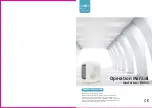
Do not charge more than the specified amount of
refrigerant. This is to prevent the compressor from
malfunctioning.
The refrigerant type is clearly marked on the
nameplate.
The unit is charged with refrigerant when it is shipped
from the factory. But depending on the piping
dimensions and length, the system require additional
refrigerant.
Only use tools specific to the type of system
refrigerant to make sure the system can withstand the
pressure, and prevent foreign objects from entering
the system.
Follow the steps below to charge the liquid
refrigerant:
Open the refrigerating cylinder slowly.
Charge the liquid refrigerant. Charging with gas
refrigerant may hamper normal operations.
1.2.4 Electricity
Take appropriate precautions to prevent
refrigerant leakage. If the refrigerant gas
leaks, ventilate the area immediately.
Possible risk: An excessively high
concentration of refrigerant in an enclosed
area can lead to anoxia (oxygen deficiency).
The refrigerant gas may produce a toxic gas
if it comes in contact with fire.
Refrigerant must be recovered. Do not
release it to the environment. Use the
vacuum pump to draw the refrigerant out
from the unit.
WARNING
Make sure you switch off the power of the
unit before you open the electric control box,
and access any circuit wiring or components
inside. At the same time, this prevents the
unit from being accidentally powered up
during installation or maintenance work.
Once you open the cover of the electric
control box, do not let any liquid spill into the
box, and do not touch the components in the
box with wet hands.
Cut off power suppy more than 10 minutes
prior to access the electrical parts. Measure
the voltage of the main circuit capacitor or
electrical components terminals to make sure
the voltage is less than 36 V before you touch
any circuit component. Refer to the
connections and wiring on the nameplate for
the master circuit terminals and connections.
The installation must be completed by
professionals, and must comply with local
laws and regulations.
Make sure the unit is grounded, and the
grounding must conform to the local law.
Use only copper core wires for installation.
Wiring must be carried out in accordance with
what is stated in the nameplate.
The unit does not include a safety switch
device. Make sure a safety switch device that
can completely disconnect all polarities is
included in the installation, and that the
safety device can be completely
disconnected when there is excessive
voltage (such as during a lightning strike).
Make sure the wiring ends are not subjected
to any external force. Do not pull or squeeze
the cables and wires. At the same time, make
sure the wiring ends are not in contact with
the piping or sharp edges of the sheet metal.
Do not connect the earth wire to public pipes,
telephone earth wires, surge absorbers and
other places that are not designed for
grounding. A gentle reminder that improper
grounding may cause electric shock.
Use a dedicated power supply cord for the
unit. Do not share the same power source
with other equipment.
A fuse or circuit breaker must be installed,
and these must conform to the local law.
Make sure an electric leakage protection
device is installed to prevent electric shocks
or fire. The model specifications and
characteristics (anti high-frequency noise
characteristics) of the electric leakage
protection device are compatible with the unit
to prevent frequent tripping.
Make sure a lightning rod is installed if the
unit is placed on the roof or other places that
can be easily struck by lightning.
Use H05RN-F, H07RN-F or above type
power cord.
WARNING
NOTE
Make sure the refrigerant piping is installed in
accordance with the applicable law. In
Europe, EN378 is the applicable standard.
Make sure the piping and connections are
not placed under pressure.
After all the piping connections have been
completed, check to make sure there is no
gas leak. Use nitrogen to conduct the leak
check for gas.
Do not charge refrigerant before the wiring
layout is completed.
Only charge the refrigerant after the leak
tests and vacuum drying have been
completed.
When charging the system with refrigerant,
do not exceed the allowable charge to
prevent liquid strike.
CAUTION
Once refrigerant charging is completed or
suspended, close the refrigerant tank valve
immediately. The refrigerant may volatilize if the
refrigerant tank valve is not closed in time.
2








































